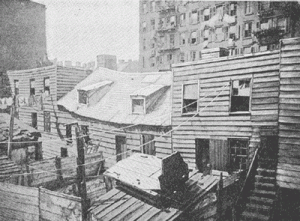The Five Points: Fact vs Fiction
Since the very beginning, the Five Points has been depicted as a neighborhood filled with brothels, gangs, poverty, saloons and crime. The mysteriousness and danger associated with the neighborhood made it a very appealing setting for many novels and movies. Consequently, the popular narrative persisted as the only version of the Five Points. This narrative has very little basis in truth. The story of the Five Points is a great way to demonstrate how archaeology can help debunk harmful, and untruthful biases.
One of the first issues with the Five Points narrative is that it is from the perspective of people who did not live in the neighborhood. A way to fix the biases is to allow people who lived in the neighborhood to tell their own story. Archaeology can help provide the evidence needed to tell that narrative.
While digging at the site of an Irish tenement and saloon archaeologists found artifacts that suggest the neighborhood was not as poor as had been previously assumed. They found a variety of fashionable household goods and clothing, which suggests that the tenants made enough money to have excess after meeting their basic food and housing needs. This is not what was expected. It is clear from the artifacts the narrative being told is a myth. It is hard to get a full archaeological picture because many of the artifacts were destroyed in 9/11. It becomes even more complicated because, in much of the literature on the neighborhood, it is described as a signature slum. Since this is the case it makes it particularly hard to come up with any alternative narrative.
As Reckner so beautifully puts it, “Long before historians’ formal work reaches the attention of most readers (if it ever does), images of the past in the form of novels and newspapers, movies, and television programs have powerfully shaped popular understandings of the past (Barthes, 1988; Leone and Silberman, 1995). This is particularly true in a place like New York City, which figures prominently in national media and mythology (Bodnar, 1992).” The five points allows archaeologists to explore how these narratives come about and why they persist.
As someone from New York, there are still areas of the city that are looked down on the same way as the Five Points. There are certain neighborhoods that my parents tell me to be wary of anytime I go to them. There are no reasons why they should tell me that other than that those neighborhoods are associated with people of lower socioeconomic status. Even then there is no reason why I should be told to be any more careful than I am in my own neighborhood. It just goes to show that the city is organized in a similar manner as it was back in the 1900s and that the same stereotypes still exist today. The neighborhoods are still organized by socio-economic status and as such the myths about those neighborhoods are very much a part of the culture.
Sources:http://archive.archaeology.org/online/features/wtcartifacts/
http://r2.gsa.gov/fivept/wdat3.htm
http://link.springer.com/article/10.1023/A%3A1016032604726
Photos: http://theredlist.com/media/database/settings/cinema/2000-2010/gangs-of-new-york/013-gangs-of-new-york-theredlist.jpg
http://www.lacndb.com/php/America/Five%20Points.gif
Further Reading:
South Street Seaport Museum – History and Archaeology of the Port of New York
N-YHS – The New-York Historical Society
ASHP – The American Social History Project “Who Built America?” Educational Film Series – Five Points Documentary Film



Archaeology often gives new narratives that either add or counter the current historical narrative. Do all cities currently or in the archaeological record have neighborhoods with negative stereotypes associated with it? Are there any cities in which this was not found and what makes them different so that this doesn’t happen?
Well, I do not know of any neighborhoods that don’t have any negative stereotypes associated with them. For example, the East End in London is considered a “bad” neighborhood and has stereotypes associated with prostitution and uneducated/unintelligent people because they are poor. I am not sure how to disassociate those negative stereotypes from these poorer neighborhoods. A good place to start would be not associating these stereotypes with the people who live in the poorer neighborhood. By disassociating the stereotypes from the residents of poorer neighborhoods we would effectively be disassociating them from the neighborhood they live in.